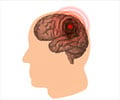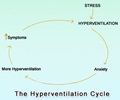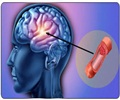A stroke also referred to as brain attack”. Read more to learn more.
Stroke, the most common cause of adult disability, has the power to transform lives permanently. It impacts the victims and their families by robbing them of their independence. Stroke is the third leading cause of adult deaths in the United States.
A stroke, also referred to as "brain attack”, results when the blood supply to the brain is obstructed. A decreased blood supply is synonymous with low levels of oxygen which leads to the death of brain cells and, finally, stroke.Types
Stroke can be largely categorized into two types:-
• Ischemic strokes are those that result due to a blockage of blood vessel in the neck or brain. 80% of strokes are ischemic. This blockage may be due to:
- The formation of a clot, denovo, (thrombosis), within a blood vessel of the brain or neck.
- The movement of a clot from another location within the body to the neck or the brain (embolism).
- Stenosis (or narrowing) of an artery inside the brain or leading to it.
• Hemorrhagic strokes are those that result from internal bleeding into the brain or into the spaces surrounding the brain.
How to handle Stroke
There are two sure ways of minimizing a person’s risk of dying from a stroke. They are:-
• Understanding the symptoms / signs and risk factors of stroke
• Controlling the risk factors
Symptoms and Signs of Stroke
If any of the following symptoms are experienced you may be at a risk for Stroke. At such time do not hesitate to seek medical help.
• Sudden numbness / weakness in the face, arm or leg, particularly on one side
• Sudden confusion
• Sudden difficulty in speaking /comprehending
• Sudden trouble in vision in either one or both eyes
• Double vision
• Sudden headache with no apparent cause
• Sudden difficulty in walking
• Dizziness, nausea, vomiting
• Loss of balance / coordination
Sometimes these signs may last for a few minutes and then disappear. These miniscule episodes are called ‘Transient Ischemic Attacks’ (TIAs), or ‘mini-strokes’. The brevity of these mini strokes should not deter a person from seeking medical help as they are indicative of a grave underlying condition.
Please listen to these signs to save your life!
Stroke Risk Factors
A risk factor is a medical condition or a behavioral trait that is observed in those whose chances of getting a disease is high.
Stroke is universal—it affects people - of all age groups, of both genders—who belong to all the races all through the world. The ethnicity of the African American makes them more prone to stroke compared to other ethnic groups, within the United States.
Stroke can even affect a fetus inside its mother’s womb.
Age is another factor which makes an individual more prone to get a stroke.
But there are other treatable risk factors for stroke that can be identified, monitored and controlled. They are:-
• Hypertension or increased blood pressure is not known as ‘silent killer’ for nothing. It is the most severe cause of stroke.
• Cigarette smoking causes fat to accumulate in the carotid artery (the pivotal artery in the neck which supplies blood to the brain). A block in this artery could result in a stroke.
• Heart diseases-Coronary artery disease, arrhythmia, valve defects, and enlargement of a chamber of the heart are all risk factors for stroke.
• Diabetes-People with uncontrolled diabetes have a greater chance of developing stroke, as the high sugar levels can damage blood vessels throughout the body including the brain.
• Mini Stroke-Episodes of Stroke–related symptoms are signs of an underlying disease. Those experiencing these symptoms stand a greater chance of suffering stroke
An inactive lifestyle, high alcohol consumption and stress are also among the lists of risk factors.
Preventing Stroke
Stroke can be prevented if the risks are understood and controlled. Certain lifestyle measures may be adopted to minimize the risks of developing stroke, some of which are listed below-
• Go for regular health checkups
• Control blood pressure from being elevated
• Lose weight if necessary
• Check cholesterol and sugar levels
• Quit smoking
• Eat plenty of fruits and vegetables to ensure adequate potassium supply
• Eat low fat foods
• Minimize salt intake
• Exercise regularly for a minimum of thirty minutes.
Medications may be given to the patient to lower blood pressure after evaluating their risks. Sometimes a surgery may be required to remove a clot.
Harboring a risk factor for stroke does not mean a person will definitely suffer a stroke. Not having a risk factor does not protect one from the chances of a stroke. But the chances do increase with the number of risk factors.
It would pay to be vigilant and heed the warning signs.
Source-Medindia
Dr. REEJA THARU/L













